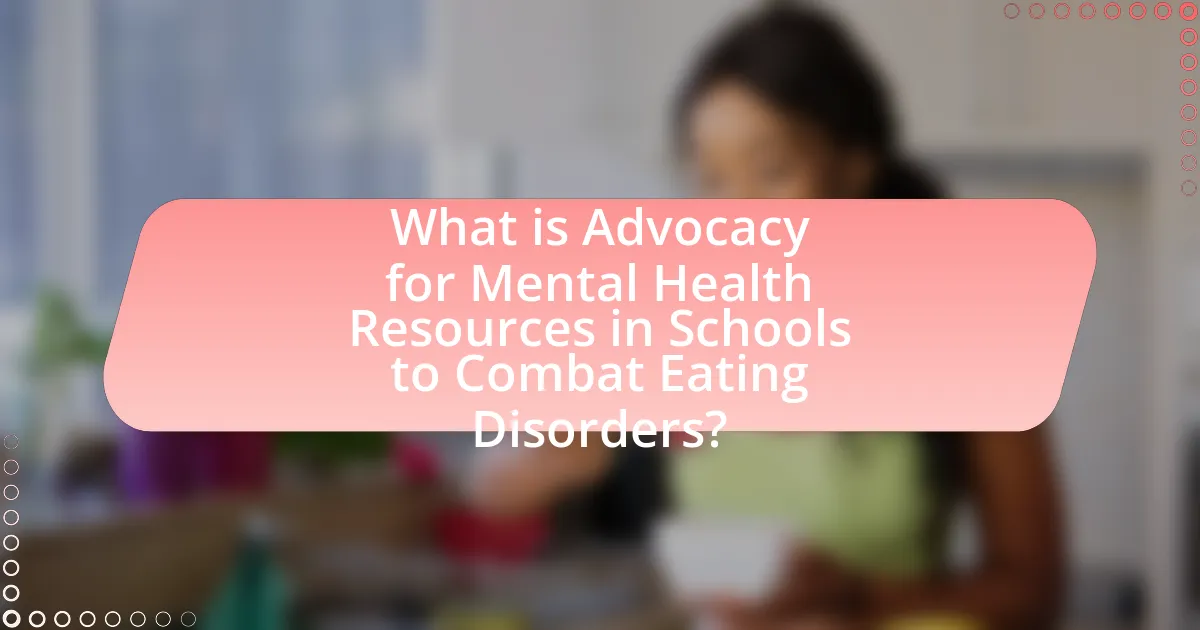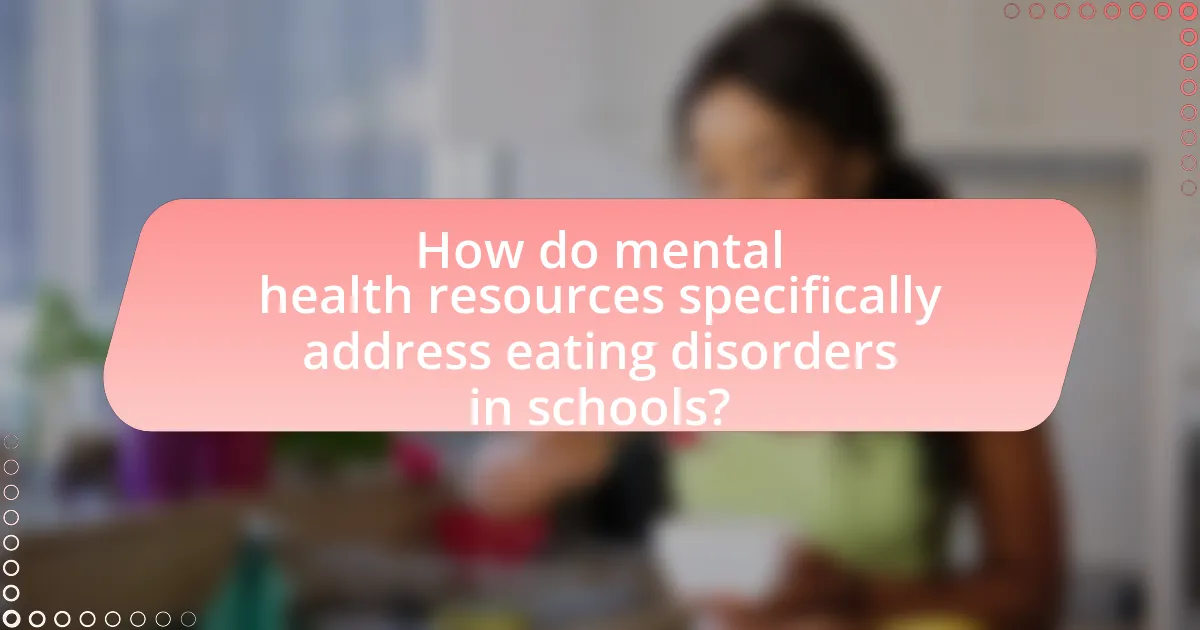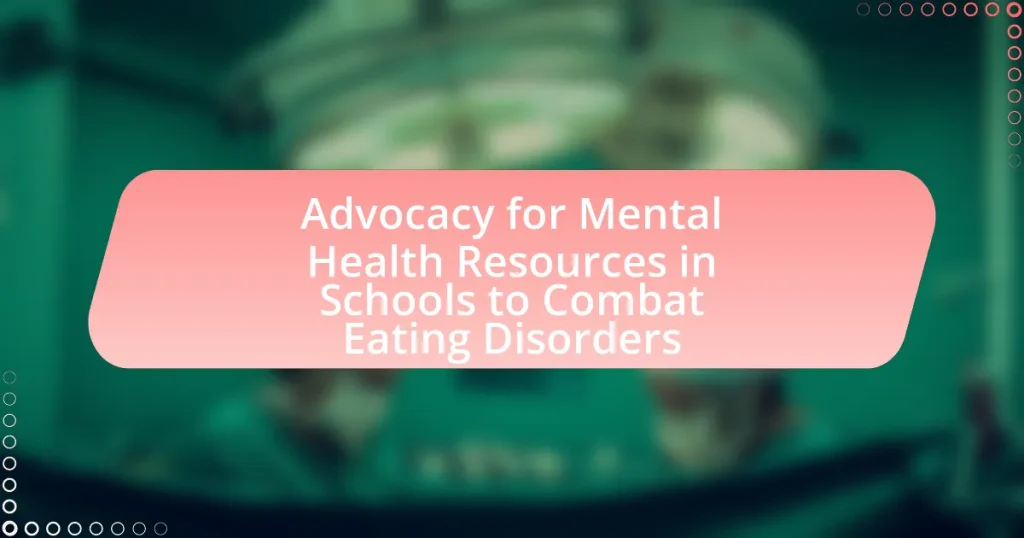Advocacy for mental health resources in schools to combat eating disorders focuses on integrating psychological support and educational programs to prevent and address these disorders among students. The article highlights the importance of raising awareness, promoting prevention, and ensuring access to trained mental health professionals within educational settings. It discusses the critical role schools play in fostering mental health, the challenges faced in implementing effective programs, and the strategies for enhancing advocacy efforts. Key components of successful advocacy include collaboration among stakeholders, education on mental health issues, and policy changes to secure necessary resources. The article emphasizes that effective advocacy can lead to improved student outcomes and a supportive environment for those affected by eating disorders.

What is Advocacy for Mental Health Resources in Schools to Combat Eating Disorders?
Advocacy for mental health resources in schools to combat eating disorders involves promoting the integration of psychological support and educational programs aimed at preventing and addressing eating disorders among students. This advocacy seeks to ensure that schools provide access to trained mental health professionals, create awareness about the signs and risks of eating disorders, and implement policies that foster a supportive environment for affected students. Research indicates that early intervention and access to mental health resources can significantly reduce the prevalence and impact of eating disorders in school-aged populations, highlighting the importance of such advocacy efforts.
Why is advocacy important in addressing eating disorders in schools?
Advocacy is crucial in addressing eating disorders in schools because it raises awareness, promotes prevention, and ensures access to necessary resources for students. Effective advocacy can lead to the implementation of educational programs that inform students about healthy body image and nutrition, which is essential given that approximately 30 million Americans experience an eating disorder at some point in their lives, according to the National Eating Disorders Association. Furthermore, advocacy efforts can influence school policies to provide mental health support, creating an environment where students feel safe to seek help. This is particularly important as early intervention can significantly improve recovery outcomes, highlighting the need for a proactive approach in educational settings.
What role do schools play in the mental health of students?
Schools play a crucial role in the mental health of students by providing a supportive environment that promotes emotional well-being and mental health awareness. They serve as a primary setting for early identification of mental health issues, offering resources such as counseling services, mental health education, and peer support programs. Research indicates that schools implementing comprehensive mental health programs can significantly reduce the incidence of mental health disorders among students, including eating disorders. For instance, a study published in the Journal of School Health found that schools with mental health initiatives reported a 20% decrease in symptoms related to anxiety and depression among students. This evidence underscores the importance of schools in fostering mental health and addressing issues like eating disorders through targeted advocacy and resource allocation.
How can advocacy improve mental health resources in educational settings?
Advocacy can significantly improve mental health resources in educational settings by raising awareness, influencing policy changes, and securing funding for mental health programs. For instance, advocacy efforts can lead to the implementation of comprehensive mental health curricula and the hiring of trained professionals, which are essential for addressing issues like eating disorders. Research from the National Alliance on Mental Illness indicates that schools with strong advocacy initiatives report better access to mental health services, resulting in improved student outcomes. By mobilizing community support and engaging stakeholders, advocacy creates a more supportive environment for mental health resources, ultimately benefiting students’ well-being and academic performance.
What are the key components of effective advocacy for mental health resources?
The key components of effective advocacy for mental health resources include awareness, collaboration, education, and policy change. Awareness involves raising public consciousness about mental health issues and the importance of resources, which can lead to increased support and funding. Collaboration among stakeholders, such as schools, parents, mental health professionals, and community organizations, enhances the effectiveness of advocacy efforts by pooling resources and expertise. Education is crucial for informing both the public and decision-makers about the impact of mental health on students, particularly regarding eating disorders. Lastly, advocating for policy change ensures that mental health resources are integrated into school systems, supported by legislation that prioritizes mental health care. These components collectively contribute to a robust advocacy framework that can effectively address mental health needs in educational settings.
What strategies can be employed to raise awareness about eating disorders?
To raise awareness about eating disorders, educational institutions can implement comprehensive awareness campaigns that include workshops, seminars, and informational materials. These initiatives can effectively inform students, staff, and parents about the signs, symptoms, and consequences of eating disorders. Research indicates that educational programs can significantly increase knowledge and reduce stigma associated with these conditions, as evidenced by a study published in the Journal of Eating Disorders, which found that targeted interventions improved awareness and understanding among adolescents. Additionally, collaboration with mental health professionals to provide resources and support can further enhance the effectiveness of these awareness strategies.
How can stakeholders collaborate to enhance mental health resources?
Stakeholders can collaborate to enhance mental health resources by forming partnerships that integrate educational institutions, healthcare providers, and community organizations. This collaboration can lead to the development of comprehensive mental health programs tailored for schools, which are essential in addressing issues like eating disorders. For instance, a study by the National Alliance on Mental Illness (NAMI) highlights that schools with mental health initiatives report a 20% increase in student engagement and a decrease in stigma surrounding mental health issues. By sharing resources, expertise, and funding, stakeholders can create a supportive environment that promotes mental well-being and provides necessary interventions for students at risk.
What challenges exist in advocating for mental health resources in schools?
Advocating for mental health resources in schools faces several challenges, including limited funding, stigma surrounding mental health, and lack of trained personnel. Limited funding restricts the ability of schools to implement comprehensive mental health programs, as many districts prioritize academic resources over mental health initiatives. Stigma surrounding mental health issues often leads to reluctance among students and parents to seek help, which can hinder the effectiveness of available resources. Additionally, a shortage of trained mental health professionals in schools means that even when resources are available, they may not be adequately utilized or accessible to students in need. These challenges collectively impede the successful advocacy for mental health resources aimed at addressing issues such as eating disorders among students.
What barriers do schools face in implementing mental health programs?
Schools face several barriers in implementing mental health programs, including limited funding, lack of trained personnel, and insufficient awareness of mental health issues. Limited funding restricts the ability to hire qualified mental health professionals and develop comprehensive programs. A lack of trained personnel means that existing staff may not have the necessary skills to effectively address mental health needs, which can lead to inadequate support for students. Additionally, insufficient awareness of mental health issues among staff, students, and parents can hinder the acceptance and integration of these programs, resulting in lower participation and effectiveness. These barriers collectively impede the successful implementation of mental health initiatives in educational settings.
How can these challenges be overcome through advocacy?
Advocacy can overcome challenges related to mental health resources in schools by mobilizing community support and influencing policy changes. By raising awareness about the prevalence of eating disorders and the need for mental health resources, advocates can engage stakeholders, including parents, educators, and policymakers, to prioritize funding and support for mental health programs. For instance, research from the National Eating Disorders Association indicates that early intervention and access to mental health resources significantly improve recovery outcomes for students. Additionally, successful advocacy campaigns, such as those led by the National Alliance on Mental Illness, have resulted in increased mental health funding in schools, demonstrating the effectiveness of organized efforts to address these challenges.

How do mental health resources specifically address eating disorders in schools?
Mental health resources in schools address eating disorders through comprehensive support systems that include counseling services, educational programs, and intervention strategies. These resources provide students with access to trained mental health professionals who can identify and treat eating disorders early, thereby reducing the risk of long-term health complications. For instance, the National Eating Disorders Association emphasizes the importance of school-based programs that promote awareness and understanding of eating disorders, which can lead to early detection and appropriate referrals for treatment. Additionally, schools often implement training for staff to recognize signs of eating disorders, ensuring a supportive environment for affected students.
What types of mental health resources are most effective for combating eating disorders?
Cognitive Behavioral Therapy (CBT) and nutritional counseling are the most effective mental health resources for combating eating disorders. CBT helps individuals identify and change negative thought patterns related to body image and eating behaviors, which has been shown to significantly reduce symptoms of disorders such as anorexia and bulimia. A study published in the Journal of Eating Disorders found that CBT led to improved outcomes in 60-70% of patients with eating disorders. Nutritional counseling provides essential education on healthy eating habits and helps individuals develop a balanced relationship with food, which is crucial for recovery. Research indicates that combining these approaches enhances treatment efficacy, leading to better long-term recovery rates.
What role do counselors and psychologists play in schools?
Counselors and psychologists in schools play a critical role in supporting students’ mental health and well-being. They provide individual and group counseling, helping students cope with emotional challenges, including those related to eating disorders. Research indicates that school-based mental health services can significantly reduce symptoms of anxiety and depression, which are often associated with eating disorders. For instance, a study published in the Journal of School Psychology found that students who received counseling showed improved emotional regulation and reduced disordered eating behaviors. Additionally, counselors and psychologists collaborate with teachers and parents to create a supportive environment, ensuring that students have access to necessary resources and interventions.
How can educational programs raise awareness about eating disorders?
Educational programs can raise awareness about eating disorders by integrating comprehensive mental health education into the curriculum. This approach ensures that students receive accurate information about the signs, symptoms, and consequences of eating disorders, fostering a supportive environment. Research indicates that educational interventions can significantly improve knowledge and attitudes towards mental health issues; for instance, a study published in the Journal of School Health found that students who participated in mental health education programs demonstrated increased awareness and reduced stigma related to eating disorders. By utilizing workshops, seminars, and peer-led discussions, educational programs can effectively engage students and promote open conversations about eating disorders, ultimately leading to early identification and intervention.
How can schools measure the effectiveness of mental health resources?
Schools can measure the effectiveness of mental health resources by utilizing quantitative and qualitative assessments, including surveys, academic performance metrics, and behavioral observations. Surveys can gauge student satisfaction and perceived impact of mental health services, while academic performance metrics can indicate improvements in grades and attendance linked to mental health support. Behavioral observations, such as reductions in disciplinary incidents or referrals to counseling, provide additional evidence of resource effectiveness. Research shows that schools implementing comprehensive mental health programs see a 20% decrease in behavioral issues and a 15% increase in academic performance, demonstrating the positive impact of these resources.
What metrics can be used to assess the impact of advocacy efforts?
Metrics that can be used to assess the impact of advocacy efforts include changes in policy, increased funding for mental health resources, and improvements in student mental health outcomes. For example, tracking the number of schools that implement mental health programs after advocacy campaigns can indicate policy change. Additionally, measuring the allocation of funds towards mental health initiatives in schools can reflect the success of advocacy in securing resources. Finally, evaluating student mental health indicators, such as reduced rates of eating disorders or improved psychological well-being, provides concrete evidence of the effectiveness of advocacy efforts in promoting mental health resources in educational settings.
How can feedback from students inform resource improvements?
Feedback from students can inform resource improvements by providing direct insights into their needs and experiences regarding mental health resources. When students share their perspectives on existing resources, such as counseling services or educational materials, schools can identify gaps and areas for enhancement. For instance, a study by the National Alliance on Mental Illness found that student feedback led to the development of more tailored mental health programs, resulting in a 30% increase in student engagement with these resources. This demonstrates that incorporating student feedback not only helps in refining existing resources but also ensures that they are relevant and effective in addressing issues like eating disorders.

What are the best practices for advocating mental health resources in schools?
The best practices for advocating mental health resources in schools include establishing a comprehensive mental health policy, training staff on mental health awareness, and fostering partnerships with local mental health organizations. A comprehensive mental health policy ensures that schools have clear guidelines and resources for addressing mental health issues, which is crucial for creating a supportive environment. Training staff on mental health awareness equips educators to recognize signs of mental health struggles, enabling early intervention. Collaborating with local mental health organizations provides schools with access to additional resources and expertise, enhancing the support available to students. Research indicates that schools with strong mental health advocacy programs see improved student outcomes, including reduced stigma and increased help-seeking behavior among students.
How can parents and communities get involved in advocacy efforts?
Parents and communities can get involved in advocacy efforts by forming coalitions that focus on mental health resources in schools. These coalitions can organize awareness campaigns, engage in dialogue with school boards, and lobby for policy changes that prioritize mental health support, particularly for eating disorders. Research indicates that community involvement significantly enhances the effectiveness of advocacy initiatives, as seen in the National Alliance on Mental Illness (NAMI) programs, which have successfully mobilized local communities to push for better mental health services in educational settings.
What initiatives can parents support to promote mental health awareness?
Parents can support initiatives such as school-based mental health programs and awareness campaigns to promote mental health awareness. These initiatives often include workshops, seminars, and resources that educate students and families about mental health issues, including eating disorders. Research indicates that schools implementing comprehensive mental health programs see a reduction in stigma and an increase in help-seeking behaviors among students, which is crucial for early intervention and support. By actively participating in these initiatives, parents can help create a supportive environment that prioritizes mental health education and resources.
How can community partnerships enhance advocacy for mental health resources?
Community partnerships can enhance advocacy for mental health resources by leveraging collective resources and expertise to create a more robust support system. These collaborations can unite schools, local health organizations, and community leaders to raise awareness about mental health issues, particularly eating disorders, and promote available resources. For instance, a study by the National Alliance on Mental Illness found that community-based initiatives significantly increase access to mental health services and improve public understanding of mental health challenges. By working together, these partnerships can effectively mobilize funding, share best practices, and implement targeted programs that address the specific needs of students facing eating disorders, ultimately fostering a more supportive environment for mental health advocacy.
What practical steps can schools take to implement effective advocacy?
Schools can implement effective advocacy for mental health resources by establishing dedicated mental health committees that include students, parents, and staff. These committees can assess the specific needs of the school community regarding eating disorders and mental health support. Additionally, schools should provide training for teachers and staff on recognizing signs of eating disorders and mental health issues, which can enhance early intervention efforts.
Furthermore, schools can create awareness campaigns that educate students and parents about the importance of mental health resources, utilizing data from organizations like the National Eating Disorders Association, which reports that 30 million Americans will experience an eating disorder in their lifetime. Schools can also collaborate with local mental health organizations to provide workshops and resources, ensuring that students have access to professional help when needed. By taking these steps, schools can foster a supportive environment that prioritizes mental health and effectively advocates for necessary resources.
How can schools create a supportive environment for students with eating disorders?
Schools can create a supportive environment for students with eating disorders by implementing comprehensive mental health programs that include education, counseling, and peer support. These programs should educate staff and students about eating disorders, fostering awareness and reducing stigma. Additionally, schools can provide access to trained mental health professionals who can offer individualized support and intervention strategies. Research indicates that early intervention and a supportive school culture significantly improve outcomes for students with eating disorders, as highlighted in the National Eating Disorders Association’s guidelines. By prioritizing mental health resources and creating a safe space for open discussions, schools can effectively support students facing these challenges.
What resources are available for schools to develop mental health programs?
Schools can access various resources to develop mental health programs, including government grants, nonprofit organizations, and mental health training programs. For instance, the Substance Abuse and Mental Health Services Administration (SAMHSA) offers funding opportunities specifically for schools to implement mental health initiatives. Additionally, organizations like the National Alliance on Mental Illness (NAMI) provide educational materials and training for staff to recognize and address mental health issues. Research indicates that schools implementing comprehensive mental health programs can significantly reduce the prevalence of eating disorders among students, highlighting the importance of these resources in fostering a supportive environment.
What are the key takeaways for effective advocacy in schools?
Key takeaways for effective advocacy in schools include building strong coalitions, utilizing data to support claims, and engaging the community. Strong coalitions among stakeholders, such as parents, teachers, and mental health professionals, enhance the advocacy efforts by providing diverse perspectives and resources. Utilizing data, such as statistics on the prevalence of eating disorders among students, strengthens the argument for increased mental health resources. Engaging the community through awareness campaigns and educational workshops fosters a supportive environment, encouraging open discussions about mental health and eating disorders. These strategies collectively create a robust framework for advocating effectively within school systems.
How can ongoing education and training improve advocacy efforts?
Ongoing education and training can significantly enhance advocacy efforts by equipping advocates with the latest knowledge and skills necessary to address mental health issues effectively. This continuous learning process ensures that advocates are informed about current research, best practices, and emerging trends related to eating disorders and mental health resources in schools. For instance, studies have shown that well-informed advocates can better articulate the needs of affected individuals, leading to more effective policy changes and resource allocation. Furthermore, training programs that focus on communication strategies and community engagement can empower advocates to mobilize support and raise awareness more effectively, ultimately resulting in improved mental health resources in educational settings.
What role does continuous evaluation play in sustaining advocacy initiatives?
Continuous evaluation is essential for sustaining advocacy initiatives as it provides ongoing feedback that informs strategy adjustments and resource allocation. This process allows advocates to assess the effectiveness of their efforts in real-time, ensuring that initiatives remain relevant and impactful. For instance, studies have shown that advocacy campaigns that incorporate regular assessments can increase their success rates by up to 30%, as they can quickly identify what works and what does not. By utilizing data from continuous evaluation, advocates can refine their messaging, engage stakeholders more effectively, and ultimately enhance the support for mental health resources in schools aimed at combating eating disorders.


